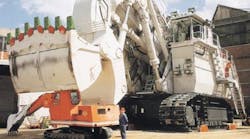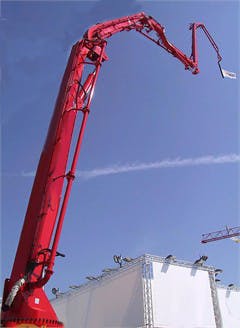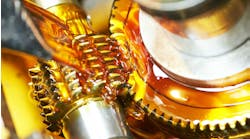Mobile equipment capitalizes on benefits of hydraulics
These advancements continue today with ever-increasing power capacities, higher reliability through improved filtration and diagnostic techniques, higher energy efficiency by implementing load-sensing circuitry, and enhanced operation through electronic control. Perhaps nothing better illustrates the strides achieved in higher power capabilities for mobile equipment than the photo at right. It shows one of the first all-hydraulic excavators dwarfed by the largest built to date, the RH400, designed and built by Orenstein and Koppel AG, of Berlin, Germany. The hydrostatic drives, implements, and other systems are powered by a pair of Cummins 2700-hp QSK60 diesel engines. The hydraulic systems are supplied by 18 variable-displacement, axial-piston pumps, eight of which are Model A7VSL1000HDs from Mannesmann Rexroth.
This earthmoving giant was delivered to Syncrude Canada Ltd., Fort McMurray, Alberta for its new North Mine project. A total of four RH-400s are used for mining oil sand, which is trucked to crushing stations and eventually mixed with hot water to form an oil sand slurry that is pumped through a pipeline to an extraction station. The process is expected eventually to produce 82 million barrels of oil per year. When the project reaches full capacity, in 2006, the four RH400s will deliver oil sand to as many as 30 trucks, each with a capacity of 320 tons. It takes only four passes of an RH400 to completely fill one of the trucks. The high reliability and efficiency of the RH400's hydraulic system, combined with other advancements, will enable production to increase while decreasing operating costs. In fact, officials project that the North Mine project will use 15% less energy than had been consumed by its predecessor, the East Mine.
Expanding the realm of possibilities
Articulated booms have become the workhorses of many industries because they can reach areas that would be inaccessible otherwise. For example, attaching a basket to the end of an articulated boom allows workers to inspect the underside of a bridge for assessing the condition of the understructure. Attaching a pair of forks allows lifting materials over or around obstacles in a crowded warehouse or storage yard. In construction, piping mounted alongside the articulated boom enables pumping concrete directly to a work site. This saves a tremendous amount of time over dumping concrete into a trough and transporting it in small batches to the work site.
But no matter what the industry, the number of joints in articulated booms and their reach have been limited by weight. Much of this weight is attributed to the hydraulic cylinders that provide power for movement. Reducing weight of the hydraulic cylinders, then, would make it possible to expand the capabilities of an articulated boom. Reducing the bore (and, therefore, weight) of the cylinder is one way of accomplishing this. But unless hydraulic system pressure is increased substantially, the cylinder will be unable to generate enough force to maintain an equivalent load rating. Furthermore, designing a hydraulic system to operate at higher pressure can add substantially to its cost.
Gross vehicle weight is important because laws restrict the weight-per-axle that a vehicle can carry and the number of axles allowed on specific roads. And because adding length to a boom would increase its weight, a longer articulated boom would have to be made of more expensive, higher-strength materials to avoid having to add another axle to the vehicle. Incorporating an additional axle to what is generally used today would require special licensing for the vehicle. But special licensing adds to the cost of a project and almost certainly leads to production delays. Therefore, the ideal articulated boom would have a longer reach or more joints, yet weigh no more than what is commonly used.
Widely used welded cylinders made of high-strength steel exhibit a high strength-to-weight ratio, but a new type of cylinder holds potential to more than double the strength density of hydraulic cylinders. Having a geometry similar to standard tie-rod cylinders, the new cylinder design uses a barrel made of carbon fiber-reinforced plastic (CFRP) wrapped around and bonded to a thin stainless steel sleeve.
Lighter cylinders improve design
Designed and manufactured by Lingk & Sturzebecher Gmbh, Stuhr, Germany, the CFRP cylinders have been made in a variety of sizes, shapes and configurations for use in robots, helicopters, foundation jacks, and, of course, articulated booms. Carsten H. Müller, president and owner of Lingk & Sturzebecher, revealed that his company recently won a contract with Airbus Industries to supply CFRP cylinders for use in commercial aircraft. Furthermore, he said his cylinders also are used in the M55 concrete pump manufactured by Putzmeister, Aichtal, Germany. At 55 m (180 ft), the M55 has the highest vertical reach in the world for an articulated-boom concrete pump.
Müller explained that as stroke increases, the weight of the barrel becomes a higher percentage of a cylinder's overall weight. He mentioned that in a steel cylinder, weight of the cylinder's end caps remains constant as stroke increases, and weight of the piston rod increases with stroke. But, according to Müller, because the barrel weighs so much more than the rod per inch of stroke (especially if the cylinder has a large bore and relatively small-diameter rod), as much as 75% of a cylinder's weight could be attributed to the barrel.
Müller continued by saying that a CFRP barrel weighs only a fraction of what a steel barrel of the same bore weighs. Furthermore, he said the CFRP barrel also exhibits a much higher tensile strength than steel, so a thin-walled CFRP barrel can withstand high pressure. He cited 350 bar (5800 psi) as the maximum rated working pressure for CFRP cylinders used in the concrete pump pictured at the bottom of this page. He also explained that the stainless steel liner provides an ideal surface for the piston seal to achieve low leakage and long life.
How much lighter are the CFRP cylinders? That depends, of course, on bore, stroke, rod diameter, and other considerations. But Müller revealed that the average CFRP cylinder weighs about 60% less than the steel cylinder it typically replaces, such as in mobile equipment. He admitted, though, that CFRP cylinders cost more than conventional cylinders, but that this can be justified by the weight savings. In general, he said, a CFRP cylinder may cost twice as much as a conventional cylinder, but weigh half as much. The weight saved by using the CFRP cylinders allows other improvements in the equipment design, so the CFRP cylinders add only a small increment to overall manufacturing cost but make a huge contribution to improved design. And as with most new technologies, Müller expects the cost differential to shrink as production volume increases.
CFRP cylinders are now part of Parker Hannifin GmbH, Kaarst, Germany. For more information, phone +49 (0)213 140 160 or click here.
Reservoirs for mobile equipment
Hydraulic reservoirs for mobile equipment are expected to perform the same functions as their industrial counterparts - but usually under more adverse and less predictable operating conditions. Machine motion (which makes complex baffling systems necessary to prevent fluid sloshing) and extreme ambient temperatures are just two examples of the special problems faced by designers of hydraulic systems for mobile equipment.
Cold temperatures can cause water to condense on the interior surfaces of the reservoir. Unless a means is provided to remove condensate from the hydraulic fluid, that water will act as a contaminant to degrade system performance and reliability and shorten the life of the fluid and hydraulic components. In addition, reservoirs constructed of steel would be prone to rust and the high potential for fluid contamination it poses. Rust can be prevented simply by constructing the reservoir of engineered plastics, composites, non-ferrous metals, or steel with a corrosion-resistant coating.
Size and weight limitations may require mobile equipment to operate with reservoirs as small as the volume a pump discharges in a minute. This is roughly a third the size of a reservoir traditionally used in industrial applications. The space and shape limitations mobile equipment place on reservoirs usually requires that they be custom designed. Cost, size, and weight must be minimized, while still maintaining adequate performance and efficiency.
Internal or external filters?
Return filters are often placed inside the tank to save space and to provide integral diffusion. One advantage of in-tank return filtration is that filling the tank through the filter helps ensure system cleanliness. However, be sure contaminants cannot fall into the reservoir when a return filter element is changed. Placing filters within the tank provides a neat design but may promote contaminating an area that is difficult to keep clean. While more difficult to plumb, external return filters keep contamination outside the tank, and they are more easily accessible for servicing.
Magnets should be placed in the reservoir to trap ferrous particles. Dams and suction strainers also can be added to increase the effectiveness of the reservoir as a solid contaminant controller. Particle dams, placed between the return and suction areas of the tank, help contain heavier particles that may have bypassed the return filters. Dams commonly consist of an angle plate that extends across the floor of the tank. The dam should be high enough to contain particles until the reservoir is routinely cleaned, but low enough to prevent fluid from having to cascade over it. Dams also provide ideal mounting surfaces for magnets.
Locating a pump at or above fluid level and far away from the tank (more the rule than the exception with mobile equipment) usually prohibits the use of pump inlet filters. Suction strainers or filters should be considered as a form of last-chance pump protection when positive pressure can be provided at the pump inlet &emdash; as with a charge pump or pressurized reservoir. When sizing suction filters, pay attention to fluid temperature (especially during startup) if equipment will operate in cold climates and pumps cannot be disengaged during startup.
Vented or pressurized reservoir?
An important design consideration is whether to specify a vented or pressurized reservoir. The major deciding factors are the location and inlet requirements of the pumps. The fluid level of the reservoir in many mobile applications is below the pump inlet. At best, if there is vacuum at the pump inlet, the pump may have to be derated. If inlet line losses are great enough, cavitation will occur. In these cases, pressurizing the reservoir will help maintain pump performance.
There are three ways to pressurize a reservoir on most mobile equipment:
• if available, use regulated compressed air from a machine's pneumatic system. This is the most effective method
• trap the air within the reservoir clearance volume (above the fluid) and depend on thermal expansion of the fluid to compress this air, and thus pressurize the reservoir. A reservoir pressure cap holds pressure within the tank and relieves any excess pressure, or
• tap pressurized air from the scavenge pump of a two-cycle diesel engine.
With pressurized reservoirs, be sure to calculate stresses on reservoir walls, because even low pressures can exert substantial loads against large areas. For example, an internal pressure of only 3 psi applies a force of 1800 lb on a 20- by 30-in. wall. This force, combined with weight of hydraulic fluid, plus G forces involved in mobile equipment, can produce stresses high enough to actually work harden a metal reservoir. Work hardening makes the metal more brittle, which eventually will cause leakage when the metal is exposed to continued stress.
Wall stresses should also be calculated for vented reservoirs. High stresses develop quickly in large areas of flat plate. And again, weight of the fluid can cause large deflections. Furthermore, mounting peripheral equipment — such as ladders — to a reservoir increases the need to specify stiffening members and thicker plate.
For vented reservoirs, strong consideration should be given to using filtered breathers to reduce ingression of airborne contaminants. If equipment will be operated in cold weather, use of a filtered breather with desiccant should be considered to reduce the humidity of air drawn into the reservoir, thereby reducing the amount of moisture that can condense on interior surfaces of the reservoir. If a filtered breather is used, be sure to also specify a vacuum breaker. This type of relief valve allows air to enter the reservoir if the filter becomes clogged. A clogged filter could cause the pump to pull a vacuum in the reservoir, which could lead to pump cavitation or other problems.
In cases of extremely heavy airborne contamination, you may want to consider a breather that prevents ambient air from coming in contact with the fluid. These breathers use a bladder or diaphragm to keep the ambient air separated from the hydraulic fluid and the reservoir's interior surfaces.
Cleaning and maintenance
Access for reservoir servicing must also be taken into account. There should be provisions to drain both return and suction areas of the tank, especially if a dam is installed to separate them. Pipe couplings often are used for such drains, but SAE O-ring ports provide better sealing. Valving should also be installed to close off inlet lines when replacing pumps or other components that are mounted below fluid level.
This is often wishful thinking, but access should be provided for cleaning and maintaining the interior of the tank. Ideally, hatches should be large enough to provide enough room for service personnel to maneuver cleaning tools.
Submitted by Brian Burgess, product manager, fixed-displacement products, Parker Hannifin Corp., Hydraulic Pump & Motor Div..



